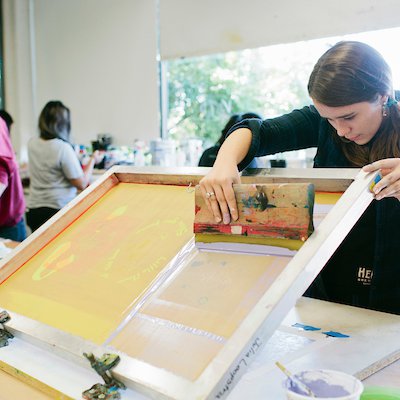ChatGPT said: 10:9 Design reviews: uncovering the strengths and weaknesses
Wiki Article
The Vital Guide to Comprehending Screen Printing and Its Versatile Uses
Screen printing has an abundant background that goes back to ancient times, evolving right into an innovative method used throughout various sectors today. This guide checks out the ins and outs of the screen printing process, describing its applications in fashion, home, and advertising and marketing style - 10:9 Design Company. Comprehending these principles can open up innovative possibility for both imaginative and industrial tasks. The following sections will certainly reveal vital pointers and methods to boost one's screen printing endeavorsThe Background of Screen Printing
Screen printing has origins that trace back centuries, its advancement mirrors the technical and artistic advancements of different societies. Originating in ancient China, the method was originally used for decorating textiles and later spread to Japan, where it became essential to Ukiyo-e woodblock printing. The method shifted to Europe in the 18th century, where it obtained appeal amongst craftsmens and commercial printers. The development of image solution in the 20th century revolutionized screen printing, enabling more elaborate styles and greater effectiveness. Musicians like Andy Warhol additionally thrust its appeal, making use of the tool to create renowned works that combined commercialism and art. By the late 20th century, screen printing had actually developed itself as a versatile technique, used in vogue, advertising and marketing, and art. Today, it remains to advance, incorporating digital modern technology and expanding its applications across various sectors.The Screen Printing Process Explained
Screen printing changes imaginative visions right into concrete designs with a collection of accurate actions. Initially, a photo is produced and after that transferred onto a screen, normally constructed from fine mesh fabric stretched over a frame. A light-sensitive emulsion is used to the screen, which is subjected to light, hardening in locations not covered by the image. After washing out the unhardened emulsion, a stencil is developed.Next, the screen is positioned over the substrate, whether it be textile, paper, or an additional material. Ink is after that pressed through the open areas of the pattern using a squeegee, depositing the layout onto the substratum below. This process can be duplicated for multiple shades, needing different displays for each shade. Lastly, the printed thing is treated utilizing heat to ensure the ink adheres correctly, causing a resilient, dynamic style on-line.
Sorts Of Screen Printing Techniques

Additionally, specialty techniques, such as discharge screen printing, eliminate color from the fabric to create softer prints, while aluminum foil screen printing applies metal foil to accomplish a glossy finish (10:9 Design Screen Printing Texas). Each strategy uses distinctive qualities, providing to various imaginative requirements and manufacturing ranges, ultimately increasing the opportunities within the screen printing domain
Applications of Screen Printing in Numerous Industries

Additionally, the signs and marketing fields make use of screen printing for creating appealing display screens and banners. This method enables strong shades and detailed layouts that capture focus. In electronics, screen printing is employed for applying conductive inks to circuit card, crucial for component connections. The home style market welcomes screen printing to generate distinctive designs on textiles and wall surface art. On the whole, screen printing works as a vital tool across diverse fields, boosting products with customized and visually attractive graphics.
Tips for Successful Screen Printing Projects
While carrying out a screen printing job, cautious interest to detail can significantly enhance the last result. Selecting high-quality materials is essential; this consists of the screen, inks, and substrates. Utilizing suitable mesh counts can affect ink deposition and information resolution. Prep work is similarly essential; comprehensive cleansing of screens and correct direct exposure times ensure crisp prints.Next, accurate enrollment is important for multi-color prints. Making use of alignment tools can assist accomplish specific layering. Furthermore, testing prints on scrap products before production aids identify possible problems without squandering resources.

Frequently Asked Questions
What Materials Are Best for Screen Printing on Fabric?
Cotton and polyester blends are perfect for screen printing on fabric due to their yard signs custom cheap resilience and ink absorption. Additionally, specialized materials like silk or canvas can generate unique textures and coatings, enhancing the general style quality.Exactly how Do I Clean and Maintain Screen Printing Devices?
To cleanse and keep screen printing tools, one must on a regular basis clean screens with appropriate solvents, evaluate mops for wear, lubricate relocating components, and store all things in a completely dry, dust-free atmosphere to extend their lifespan.What Are the Ecological Effects of Screen Printing?
Screen printing can have considerable ecological influences, including chemical waste from solvents and inks, water use during cleaning processes, and energy usage. Lasting techniques and environmentally friendly materials are vital for reducing these adverse effects.Can Screen Printing Be Done at Home Efficiently?
Screen printing can be effectively done at home with the appropriate materials and strategies. Hobbyists can develop top quality prints, though success depends upon their ability level, devices, and understanding of the procedure included.
What Are the Prices Related To Starting a Display Printing Company?

Starting a screen printing company involves prices for equipment, products, and work space. Preliminary costs typically range from a few hundred to several thousand dollars, depending upon the range, quality of machinery, and wanted manufacturing ability.
Screen printing has a rich background that dates back to old times, advancing right into a sophisticated method utilized across various markets today. An additional technique, rotating screen printing, utilizes cylindrical screens, helping with continuous printing on fabric rolls, thereby enhancing efficiency for large-scale manufacturings. In addition, specialized methods, such as discharge screen printing, eliminate color from the material to produce Visit Website softer prints, while aluminum foil screen printing applies metal aluminum foil to attain a glossy surface. In the style field, screen printing is extensively utilized to develop vivid layouts on clothing, allowing brands to display their unique styles. Cotton and polyester blends are optimal for webpage screen printing on material due to their durability and ink absorption.
Report this wiki page